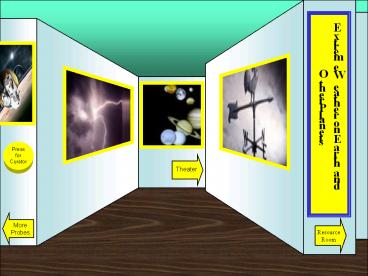Extreme Weather - PowerPoint PPT Presentation
Title:
Extreme Weather
Description:
Extreme Weather on Earth and Other Planets – PowerPoint PPT presentation
Number of Views:2119
Title: Extreme Weather
1
Museum Entrance
Extreme Weather on Earth and Other Planets
Theater
Resource Room
2
Room 2
Space Probes
Add Artifact 8
Add Artifact 5
3
Room 3
National Geographic Education
Extreme Weather on Earth and Other Planets
Add Artifact 12
Add Artifact 10
National Geographic Education has created this
interactive module to study extreme weather
patterns, both on earth and on other planets. It
is divided into five activities covering 180
minutes. Topics cover, 1) Extreme Weather on Our
Planet, 2) Extreme Weather on Other Planets, 3)
Measuring Weather with Tools, 4) Discover Space
Probes, and 5) Design Your Own Space Probe. This
module meets ISTE NETS-S Standard 1c Creativity
and Innovation - Use models and simulations to
explore complex systems and issues.
Screen Shot
4
Room 4
Our Solar System
Add Artifact 14
Click Screen to Begin
5
Discover Space Probes
- Activity 4
- Students watch a video about space probes and
discuss the function of space probes. They use a
photo gallery to compare and contrast different
structures and equipment of probes, and make
connections between the different structures and
purposes of space probes. Then students use an
interactive diagram of the Cassini space probe to
imagine what instruments they might include on a
probe of their own design. - http//education.nationalgeographic.com/education/
lesson/extreme-weather-earth-other-planets/?ar_a1
Image acquired at http//www.aerospaceguide.net/s
pacecraft/newhorizons.html
Return to Room
6
Extreme Weather on Our Planet
- Activity 1
- Students use prior knowledge, a photo gallery,
and a video to discuss what they already know
about extreme weather on Earth and brainstorm a
list of weather-related words. Then they organize
the information they learned about weather events
and conditions present for each type of weather
event, and compare and contrast weather events
and conditions.
Image acquired at http//education.nationalgeogra
phic.com/education/lesson/extreme-weather-earth-ot
her-planets/?ar_a1
Return to Room
7
Extreme Weather on Other Planets
- Activity 2
- Students compare ways of investigating weather on
Earth and on other planets in our solar system.
They use a video to discuss which different types
of weather information might help us understand
what the environments are like on each planet.
Then students compare and contrast weather
conditions for planets in our solar system.
Image acquired at http//education.nationalgeogra
phic.com/education/lesson/extreme-weather-earth-ot
her-planets/?ar_a1
Return to Room
8
Measuring Weather With Tools
- Activity 3
- Students use prior knowledge to brainstorm
instruments scientists use to measure weather.
They use a photo gallery to identify what weather
conditions each instrument measures. Then
students play a game to match illustrations of
instruments that measure weather with
descriptions of each instrument.
Image acquired at http//education.nationalgeogra
phic.com/education/lesson/extreme-weather-earth-ot
her-planets/?ar_a1
Return to Room
9
SOHO Space Probe
- The primary scientific aims of the Solar and
Heliospheric Observatory mission (SOHO) are to
investigate (1) the physical processes that form
and heat the Suns Corona, maintain it and give
rise to the expanding solar wind, and (2) the
interior structure of the Sun. The spacecraft was
launched aboard an Atlas 2-AS rocket on December
12, 1995, from Cape Canaveral, Florida. - http//www.solarviews.com/eng/soho.htm
Image acquired at cfa.harvard.edu
Return to Room
10
New Horizons Space Probe
- Cassini-Huygens space probe is on a mission to
orbit Saturn. - http//education.nationalgeographic.com/education/
lesson/extreme-weather-earth-other-planets/?ar_a1
Image acquired at http//www.google.com/imgres?im
gurlhttp//www.nasa.gov/images/content/60030main_
cassini-concept-browse.jpgimgrefurlhttp//www.na
sa.gov/mission_pages/cassini/media/release-134-052
804.htmlh600w800sz31tbnidr78_83-w_5MRbMt
bnh91tbnw121zoom1usg__wrD8d9DKHMwJivUaHXi05
rTUk4Udocid1GXDRXbAkdTxNMhlensaXeirP4nUaP
lHISp2gX1_YGoDwved0CF8Q9QEwBgdur402
Return to Room
11
Design Your Own Space Probe
- Activity 5
- Students imagine they are scientists or engineers
designing a new space probe to explore our solar
system. They choose a planet, review its weather
factors, and use a rubric to gather information,
make a plan, modify and/or test their plan, and
create their design. Students conduct peer
evaluation and revise, publish, and present their
designs.
Image acquired at http//www.google.com/imgres?im
gurlhttp//upload.wikimedia.org/wikipedia/commons
/thumb/1/19/Mars_Climate_Orbiter_2.jpg/290px-Mars_
Climate_Orbiter_2.jpgimgrefurlhttp//en.wikipedi
a.org/wiki/Mars_Climate_Orbiterh264w290sz21
tbniduA5VW3JnK8m1-Mtbnh93tbnw102zoom1usg
__1dm2eV8PFfgL29cJ9b4uIlUgBPUdocidTLpQmRgEk0mWb
MhlensaXeimfsnUa7WDKTA2AWxsoHwDAved0CEcQ9Q
EwAwdur606
Return to Room
12
NASA Mars Explorer
- The Mars Exploration Rovers are gathering data on
Mars from the ground. - http//education.nationalgeographic.com/education/
lesson/extreme-weather-earth-other-planets/?ar_a1
Image acquired at http//en.wikipedia.org/wiki/Ma
rs_Exploration_Rover
Return to Room
13
Storm Chasing
- SEPTEMBER 25, 2012
- Storm Chasing
- Photograph by Carsten Peter, National Geographic
- This Month in Photo of the Day Nature and Weather
Photos - With a 1,600-pound camera he calls the Kahuna in
tow, storm chaser Tim Samaras is on the hunt for
an elusive shot of a lightning strike the moment
it is born. - See more pictures from the August 2012
feature story "Chasing Lightning."
Image acquired at http//photography.nationalgeog
raphic.com/photography/photo-of-the-day/storm-chas
ing-peter/
Return to Room
14
Tornado, North Dakota
- SEPTEMBER 6, 2012
- Tornado, North Dakota
- Photograph by Mitch Dobrowner
- This Month in Photo of the Day Nature and Weather
Photos - Regan, North Dakota A dying tornado like this
one is said to be in the "roping out" phase. - See more pictures from the July 2012
feature story "Epic Storms."
Image acquired at http//photography.nationalgeog
raphic.com/photography/photo-of-the-day/tornado-no
rth-dakota-dobrowner/
Return to Room
15
Return to Room
16
Martin R. Zschoche
- Student Project for EDUC 422
- California State University San Marcos (CSUSM)
- Department of Education
- February, 2013
Note Virtual museums were first introduced by
educators at Keith Valley Middle School in
Horsham, Pennsylvania. This template was designed
by Dr. Christy Keeler based on one of the sample
virtual museums provided by the Keith Valley
staff at ISTEs NECC 2005. Contact Dr. Keeler for
more information about virtual museums or visit
http//christykeeler.com/EducationalVirtualMuseums
.html
Return to Room
17
Artifact 14 Title
- Add text here
Image acquired at Place URL here
Return to Room



























![Top Benefits of Quality Door Weather Stripping [Infographic] PowerPoint PPT Presentation](https://s3.amazonaws.com/images.powershow.com/10143036.th0.jpg?_=20240928036)



